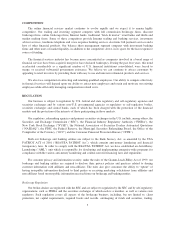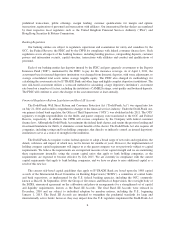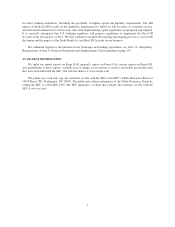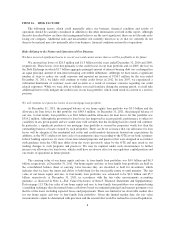eTrade 2011 Annual Report Download - page 18
Download and view the complete annual report
Please find page 18 of the 2011 eTrade annual report below. You can navigate through the pages in the report by either clicking on the pages listed below, or by using the keyword search tool below to find specific information within the annual report.changed the bank regulatory structure for our Company and its thrift subsidiaries. Portions of the Dodd-Frank
Act were effective immediately, but many provisions will only be effective after the adoption of implementing
regulations, which have been delayed in numerous cases. The key effects of the Dodd-Frank Act, when fully
implemented, on our business are:
• changes to the thrift supervisory structure;
• changes to regulatory capital requirements;
• changes to the assessment base used by depository institutions to calculate their FDIC insurance
premiums, increases in the minimum reserve ratio for the FDIC’s deposit insurance fund to 1.35%, and
imposition of the additional costs of this increase on depository institutions with assets of $10 billion or
more; and
• establishment of the CFPB with broad authority to implement new consumer protection regulations
and, for banks and thrifts with $10 billion or more in assets, to examine and enforce compliance with
federal consumer laws.
Under the legislation, the OTS was abolished in July 2011 and its functions and personnel were distributed
among the OCC, the FDIC and the Federal Reserve. Primary jurisdiction for the supervision and regulation of
savings and loan holding companies, including the Company, was transferred to the Federal Reserve; supervision
and regulation of federal savings associations, such as the Company’s three thrift subsidiaries, was transferred to
the OCC. Although the Dodd-Frank Act maintains the federal thrift charter, it eliminates certain preemption,
branching and other benefits of the charter and imposes new penalties for failure to comply with the qualified
thrift lender test. The Dodd-Frank Act also requires all companies, including savings and loan holding companies
that directly or indirectly control an insured depository institution, to serve as a source of strength for the
institution, including committing necessary capital and liquidity support.
We are required to file periodic reports with the Federal Reserve and are subject to examination and
supervision by them. The Federal Reserve also has certain types of enforcement powers over us, ETB Holdings,
Inc., and our non-depository institution subsidiaries, including the ability to issue cease-and-desist orders, force
divestiture of our thrift subsidiaries and impose civil and monetary penalties for violations of federal banking
laws and regulations or for unsafe or unsound banking practices. Our thrift subsidiaries are subject to similar
reporting, examination, supervision and enforcement oversight by the OCC. In concurrence with the transfer of
parent company supervisory authority from the OTS to the Federal Reserve, the Federal Reserve has issued
guidance aligning the supervisory and regulatory standards of savings and loan holding companies more closely
with the standards applicable to bank holding companies. The Federal Reserve had also indicated that its
supervision of savings and loan holding companies may entail a more rigorous level of review than previously
applied by the OTS.
The Dodd-Frank Act also creates a new independent regulatory body, the CFPB, which has been given
broad rulemaking authority to implement the consumer protection laws that apply to banks and thrifts and to
prohibit “unfair, deceptive or abusive” acts and practices. For all banks and thrifts with total consolidated assets
over $10 billion, including E*TRADE Bank, the CFPB has exclusive rulemaking and examination, and primary
enforcement authority, under federal consumer financial laws and regulations. In addition, the Dodd-Frank Act
permits states to adopt consumer protection laws and regulations that are stricter than those regulations
promulgated by the CFPB.
For us, one of the most significant changes under the new law is that savings and loan holding companies
such as our Company for the first time will become subject to the same capital and activity requirements as those
applicable to bank holding companies. In addition, we will be subject to the same capital requirements as those
applied to banks, which requirements exclude, on a phase-out basis, all trust preferred securities from Tier I
capital. The Dodd-Frank Act provides for a five year phase-in period for these new capital requirements. We
fully expect to meet the capital requirements applicable to thrift holding companies as they are phased in.
15
























